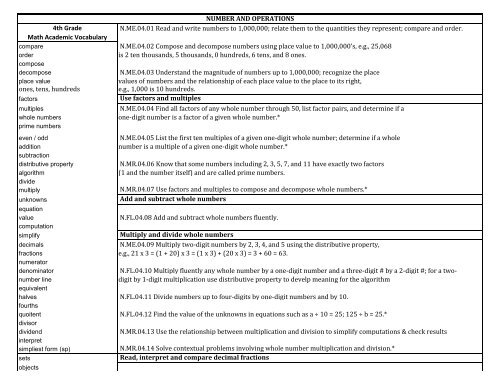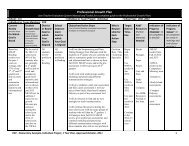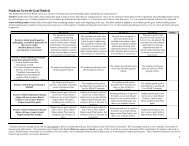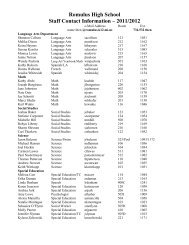4th grade math vocabulary
4th grade math vocabulary
4th grade math vocabulary
Create successful ePaper yourself
Turn your PDF publications into a flip-book with our unique Google optimized e-Paper software.
NUMBER AND OPERATIONS<br />
<strong>4th</strong> Grade<br />
N.ME.04.01 Read and write numbers to 1,000,000; relate them to the quantities they represent; compare and order.<br />
Math Academic Vocabulary<br />
compare N.ME.04.02 Compose and decompose numbers using place value to 1,000,000’s, e.g., 25,068<br />
order<br />
is 2 ten thousands, 5 thousands, 0 hundreds, 6 tens, and 8 ones.<br />
compose<br />
decompose N.ME.04.03 Understand the magnitude of numbers up to 1,000,000; recognize the place<br />
place value<br />
values of numbers and the relationship of each place value to the place to its right,<br />
ones, tens, hundreds<br />
e.g., 1,000 is 10 hundreds.<br />
factors Use factors and multiples<br />
multiples N.ME.04.04 Find all factors of any whole number through 50, list factor pairs, and determine if a<br />
whole numbers<br />
one-digit number is a factor of a given whole number.*<br />
prime numbers<br />
even / odd N.ME.04.05 List the first ten multiples of a given one-digit whole number; determine if a whole<br />
addition<br />
number is a multiple of a given one-digit whole number.*<br />
subtraction<br />
distributive property N.MR.04.06 Know that some numbers including 2, 3, 5, 7, and 11 have exactly two factors<br />
algorithm<br />
(1 and the number itself) and are called prime numbers.<br />
divide<br />
multiply N.MR.04.07 Use factors and multiples to compose and decompose whole numbers.*<br />
unknowns Add and subtract whole numbers<br />
equation<br />
value N.FL.04.08 Add and subtract whole numbers fluently.<br />
computation<br />
simplify Multiply and divide whole numbers<br />
decimals N.ME.04.09 Multiply two-digit numbers by 2, 3, 4, and 5 using the distributive property,<br />
fractions e.g., 21 x 3 = (1 + 20) x 3 = (1 x 3) + (20 x 3) = 3 + 60 = 63.<br />
numerator<br />
denominator N.FL.04.10 Multiply fluently any whole number by a one-digit number and a three-digit # by a 2-digit #; for a twonumber<br />
line<br />
digit by 1-digit multiplication use distributive property to develp meaning for the algorithm<br />
equivalent<br />
halves N.FL.04.11 Divide numbers up to four-digits by one-digit numbers and by 10.<br />
fourths<br />
quoitent N.FL.04.12 Find the value of the unknowns in equations such as a ÷ 10 = 25; 125 ÷ b = 25.*<br />
divisor<br />
dividend N.MR.04.13 Use the relationship between multiplication and division to simplify computations & check results<br />
interpret<br />
simpliest form (sp) N.MR.04.14 Solve contextual problems involving whole number multiplication and division.*<br />
sets Read, interpret and compare decimal fractions<br />
objects
fraction strips N.ME.04.15 Read and interpret decimals up to two decimal places; relate to money & place value decomposition<br />
equal<br />
mixed number N.ME.04.16 Know that terminating decimals represents fractions whose denominators are 10,<br />
number line 10 x 10, 10 x 10 x 10, etc., e.g., powers of 10.<br />
eights, thirds, sixths, twelfths<br />
greater than N.ME.04.17 Locate tenths and hundredths on a number line.<br />
improper fraction<br />
whole number N.ME.04.18 Read, write, interpret, and compare decimals up to two decimal places.<br />
order up<br />
array<br />
N.MR.04.19 Write tenths and hundredths in decimal and fraction forms, and know the decimal equivalents for halves & fourths<br />
area Understand fractions<br />
multiply N.ME.04.20 Understand fractions as parts of a set of objects.<br />
more than<br />
less than<br />
N.MR.04.21 Explain why equivalent fractions are equal, using models such as fraction strips<br />
multiple or the number line for fractions with denominators of 12 or less, or equal to 100.<br />
fractions<br />
equation N.MR.04.22 Locate fractions with denominators of 12 or less on the number line; include mixed numbers<br />
common denominator<br />
sums & differences N.MR.04.23 Understand the relationships among halves, fourths, and eighths and among thirds, sixths, & twelfths<br />
repeated addition<br />
fluently N.ME.04.24 Know that fractions of the form mn where m is greater than n, are greater than 1 and<br />
calculations<br />
are called improper fractions; locate improper fractions on the number line.*<br />
estimate<br />
product<br />
N.MR.04.25 Write improper fractions as mixed numbers, and understand that a mixed number<br />
round represents the number of “wholes” and the part of a whole remaining, e.g., .. = 1 + .. = 1 .. .<br />
approximation<br />
reasonableness N.MR.04.26 Compare and order up to three fractions with denominators 2, 4, and 8, and 3, 6,<br />
and 12, including improper fractions and mixed numbers.<br />
Add and subtract fractions<br />
N.MR.04.27 Add and subtract fractions less than 1 with denominators through 12 and/or 100,<br />
in cases where the denominators are equal or when one denominator is a multiple of the other,<br />
e.g., 1/12 + 5/12 = 6/12 1/6 + 5/12= 7/12 3/10 - 23/100= 7/100<br />
N.MR.04.28 Solve contextual problems involving sums and differences for fractions where one<br />
denominator is a multiple of the other (denominators 2 through 12, and 100).*<br />
N.MR.04.29 Find the value of an unknown in equations such as .. + x = .. or .. - y = .. .*<br />
Multiply fractions by whole numbers<br />
N.MR.04.30 Multiply fractions by whole numbers, using repeated addition and area or array<br />
models.<br />
Add and subtract decimal fractions
N.MR.04.31 For problems that use addition and subtraction of decimals through hundredths,<br />
represent with <strong>math</strong>ematical statements and solve.*<br />
N.FL.04.32 Add and subtract decimals through hundredths.*<br />
Multiply and divide decimal fractions<br />
N.FL.04.33 Multiply and divide decimals up to two decimal places by a one-digit whole number<br />
where the result is a terminating decimal, e.g., 0.42 ÷ 3 = 0.14, but not 5 ÷ 3 = 1.6.<br />
Estimate<br />
N.FL.04.34 Estimate the answers to calculations involving addition, subtraction, or multiplication.<br />
N.FL.04.35 Know when approximation is appropriate and use it to check the reasonableness<br />
of answers; be familiar with common place-value errors in calculations.<br />
N.FL.04.36 Make appropriate estimations and calculations fluently with whole numbers using mental <strong>math</strong> strategies<br />
MEASUREMENT<br />
tools<br />
formula<br />
units perimeter M.UN.04.01 Measure using common tools and select appropriate units of measure.<br />
degrees area<br />
compare dimension M.PS.04.02 Give answers to a reasonable degree of precision in the context of a given problem.<br />
integer temperatures<br />
surface area M.UN.04.03 Measure and compare integer temperatures in degrees.<br />
convert<br />
meter / centimeter M.TE.04.04 Measure surface area of cubes and rectangular prisms by covering and counting area of the faces<br />
kilograms / grams Convert measurement units<br />
liter / milliliter<br />
hour / minute/ second M.TE.04.05 Carry out the following conversions from one unit of measure to a larger or<br />
year / month<br />
smaller unit of measure: meters to centimeters, kilograms to grams, liters to milliliters, hours to<br />
inches / feet<br />
minutes, minutes to seconds, years to months, weeks to days, feet to inches, ounces to pounds<br />
ounces / pounds<br />
(using numbers that involve only simple calculations).<br />
Use perimeter and area formulas<br />
tools formula M.TE.04.06 Know and understand the formulas for perimeter and area of a square and a<br />
units perimeter rectangle; calculate the perimeters and areas of these shapes and combinations of these shapes<br />
degrees area using the formulas.<br />
compare dimension<br />
integer temperatures M.TE.04.07 Find one dimension of a rectangle given the other dimension and its perimeter or area<br />
surface area
convert M.TE.04.08 Find the side of a square given its perimeter or area.<br />
meter / centimeter<br />
kilograms / grams M.PS.04.09 Solve contextual problems about perimeter and area of squares and rectangles in compound shapes<br />
liter / milliliter Understand right angles<br />
hour / minute/ second M.TE.04.10 Identify right angles and compare angles to right angles.<br />
year / month<br />
inches / feet Problem-solving<br />
ounces / pounds<br />
M.PS.04.11 Solve contextual problems about surface area.<br />
GEOMETRY<br />
identify cube Understand perpendicular, parallel, and intersecting lines<br />
perpendicular rect. prism G.GS.04.01 Identify and draw perpendicular, parallel, and intersecting lines using a ruler & a tool or object w/ a square )90º) corner<br />
parallel<br />
pyramid<br />
intersecting 3-D Identify basic geometric shapes and their components, and solve problems<br />
corner edges G.GS.04.02 Identify basic geometric shapes including isosceles, equilateral, and right triangles,<br />
solid figures faces and use their properties to solve problems.<br />
plane figures vertices<br />
line symmetry G.SR.04.03 Identify and count the faces, edges, and vertices of basic three-dimensional geometric solids including<br />
reflection - flip<br />
cubes, rectangular prisms, and pyramids; describe the shape of their faces<br />
rotation - turn<br />
translation - slide G.TR.04.04 Recognize plane figures that have line symmetry.<br />
transformations<br />
triangles: isosceles, equilateral, right G.TR.04.05 Recognize rigid motion transformations (flips, slides, turns) of a two-dimensional object<br />
DATA AND PROBABILITY<br />
tables<br />
Represent and solve problems for given data<br />
bar graphs D.RE.04.01 Construct tables and bar graphs from given data.<br />
data set<br />
median D.RE.04.02 Order a given set of data, find the median, and specify the range of values.<br />
order<br />
range D.RE.04.03 Solve problems using data presented in tables and bar graphs, e.g., compare<br />
values<br />
data represented in two bar graphs and read bar graphs showing two data sets.





